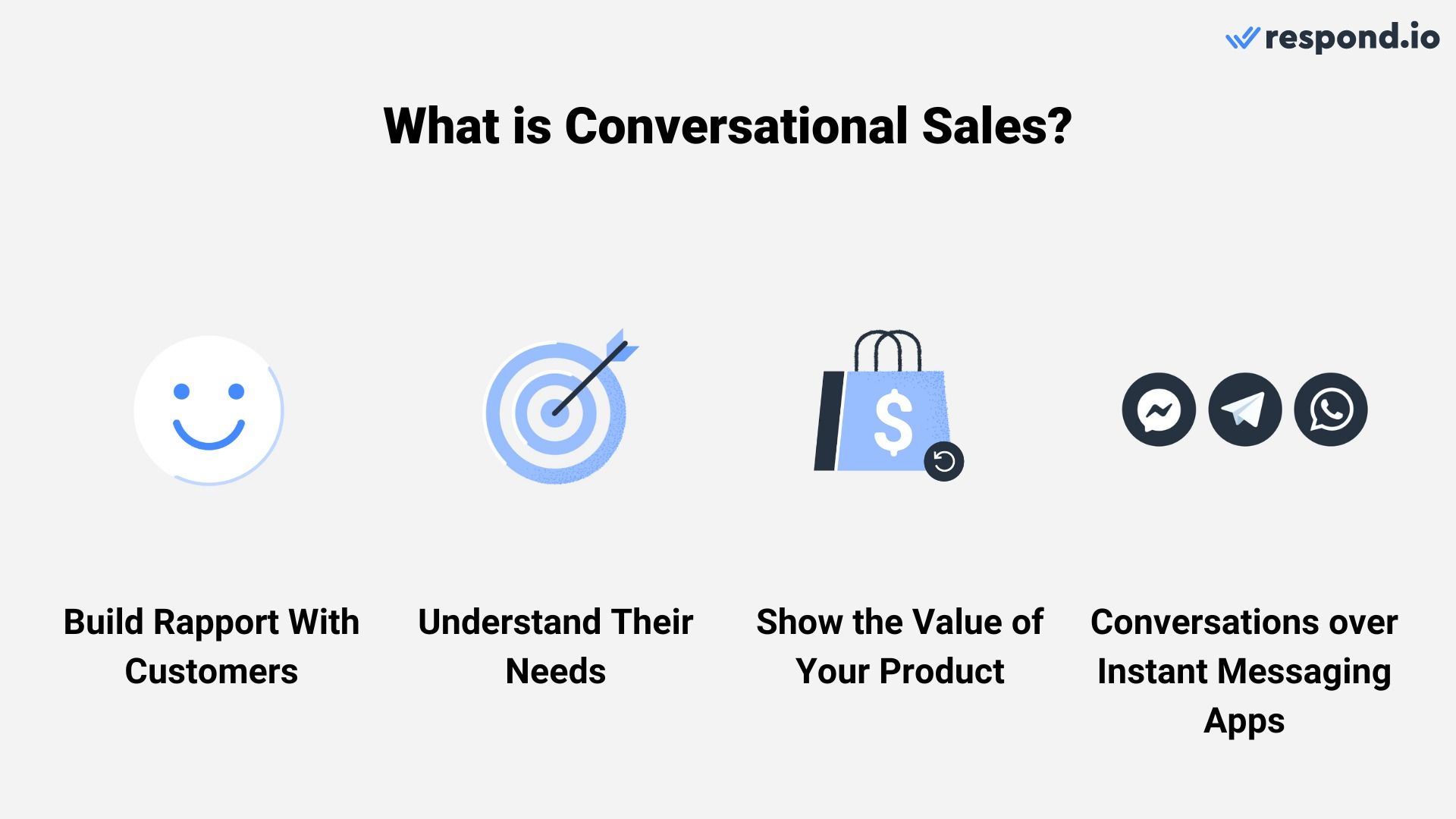
Looking to close sales leads faster? You’ve come to the right place. This blog covers how to close sales effectively. In this guide, you’ll learn what conversational sales is, why you should close a sale in 3 conversations, how to do it and best sales closing techniques.
What is Conversational Sales?
Conversational sales is an approach that treats each interaction with a lead as part of a two-way exchange. It’s not about cold calls and scripted pitches; it's about building relationships through genuine conversations.
Even in the digital age, the fundamental principles of sales remain the same—build rapport, understand your customer's needs, and demonstrate the value of your product.

But the execution has evolved. Instead of face-to-face interaction, conversations are happening on platforms like WhatsApp, Facebook, Instagram, TikTok, Telegram, Viber, LINE and more.
With the right conversational approach, you can close deals faster. Transform your sales game from a numbers race to a value-focused exchange that delights customers and grows your business. Let’s examine the best approach to conversational sales.
Why Close a Sale in Three Conversations?
Timing is everything in sales. A deal that drags on for too long can lead to a drop in customer interest. Prospects lose their initial enthusiasm or become distracted by competitors’ offerings. This delay reduces the perceived value of the product or service. It also tells customers that your sales team is inefficient or lacks commitment.
To prevent this, it’s crucial to keep the number of conversations for each customers low. Here’s why you should keep it to three conversations.
Optimizes Sales Efficiency: Limiting the core sales process to three conversations helps in managing time and resources efficiently, both for the salesperson and the customer. It prevents the sales cycle from dragging on unnecessarily, which can lead to lost interest or decision fatigue from the prospect.
Increases Closure Rates: By methodically addressing customer needs, building trust and presenting tailored solutions, this strategy can significantly increase the chances of closing a sale. It also helps in establishing a positive customer experience, which is vital for referrals and future business.
In three conversations, you can build a convincing narrative that leads your prospect to a buying decision. Each interaction maintains their interest and when done well, it leads to a win for both you and your client. Let’s look at this three conversation narrative next.
Turn customer conversations into business growth with respond.io. ✨
Manage calls, chats and emails in one place!
Sales Closing Techniques: How to Close a Sale in 3 Steps
Streamlining the sales process into three distinct steps not only simplifies the sales journey but also ensures a focused and effective approach to converting prospects into loyal customers. This method emphasizes clarity, efficiency, and the power of building relationships.
This ensures a smooth transition from initial contact to final agreement to close sales leads faster, all while maintaining a strong connection with your customer. Let's dive into the sales closing techniques, using the context of a tertiary education recruiter as an example.
Step 1: Identify Customer Challenges and Opportunities
The foundation of a successful sale lies in a deep understanding of the customer's problems and objectives. Adeel Akram, a seasoned Senior Account Executive at respond.io, demonstrates how to close sales effectively. He emphasizes the importance of showing the value or return on investment of the service offered.
In the context of education recruitment, this could involve explaining how a particular course or institution provides a better ROI in terms of career opportunities and earnings potential compared to others.
Agents should use concrete examples, such as alumni success stories or industry partnerships, to illustrate these points.
Every conversation with a prospect should have a clear goal, nudging them further in their decision-making process. By making each interaction meaningful and focused, you build a strong foundation that paves the way for a successful sale.
Step 2: Follow-Up With Customers
The second step involves delving deeper into the specifics of your offer and addressing any questions or concerns the prospect may have. This is the time to provide detailed information that highlights your competitive advantage.

For an education recruiter, this could mean personalized reports on course outcomes, comparison charts between institutions or a tour around the campus.
The key here is to tailor your follow-up to the individual's specific needs and goals, emphasizing how your offerings directly benefit them. This not only keeps the prospect engaged but also reinforces the value of your services, making it clear how they stand out from the competition.
Step 3: Close the Deal
By the time you reach the third conversation, you should be in a position to close the deal. At this stage, it's crucial to confirm that your offering is the best solution for the customer's needs.
For education recruiters, this means ensuring that the course or institution you're recommending not only meets the student's current educational and career objectives but also positions them for future success.
Closing the deal involves painting a clear picture of how your solution addresses the prospect's needs in ways that alternatives do not. It's about showing the long-term benefits, such as career growth, network building and skill development.
At this final hurdle to close sales leads faster, reinforcing the unique advantages of your offering can make all the difference, turning a prospect into a satisfied customer.
Since this is the most crucial stage, businesses should consider calling customers through the WhatsApp Business Calling API to more effectively seal the deal.
Leverage Respond.io: Best Practices to Boost Your Sales
Conducting effective sales conversations requires preparation, timing and a dose of intuition. Here are some best practices to keep in mind:
Sales Closing Techniques: Know Your Customer
Preparation is where successful sales conversations are built. Before messaging a prospect, it's crucial to set clear objectives for the conversation. Understanding what your goals are helps steer the discussion in the right place.
It ensures that you make the most of the opportunity. Objectives could range from uncovering a prospect's needs and addressing objections to securing a commitment for the next step.

On respond.io, you can qualify leads with AI Agents, so you can spend your time talking to leads who are actually likely to convert. An AI Agent can collect contact data, ask questions about budget and answer any preliminary questions the lead has to see if they're a good fit for the product or service. If they are, the AI Agent will transfer the conversation to a human sales agent. If leads are not qualified, the AI Agent can close the conversation with a summary.
Sales Closing Techniques: Build Momentum to Keep Customer Interest
Momentum is key in keeping a prospect engaged and moving through the sales funnel. Follow up promptly after each conversation. Consistency and timeliness in your follow-ups demonstrate your commitment and can keep the prospect interested.
Use tools like broadcasts to send messages to a large number of prospects in one go. This helps you connect
Sales Closing Techniques: Maintaining Relationships for Future Opportunities
Even if a deal didn’t close, maintain the relationship anyway. You never know when a prospect might be more ready to buy and you want to be top-of-mind when they are.
This also applies to existing customers. It’s much easier to get sales from an existing customer than a new one. So, make sure you maintain a relationship to upsell, cross-sell or even offer them an entirely new product.
Just like with building momentum, you can send broadcasts to prospects and customers to remind them of your offerings. Do this as a part of your retargeting campaign.
To avoid customers flagging your messages as spam on WhatsApp, ensure that you have an option to opt-out of your broadcasts. Having too many broadcasts flagged as spam can lead to an account ban.
Sales Closing Techniques: Things to Avoid
While you should take every opportunity to close a sale, there are limits. We’ll briefly go over the don’ts when closing sales.
Hard selling: Avoid this at all costs. Pressuring potential customers will only force them to back out of the conversation. Convince them about what they stand to gain, rather than telling them they have to buy your offerings.
Not asking for the sale: While you shouldn’t hard sell, you should still ask your customer if they’re ready to make a deal. Asking customers to get back to you on making a deal will result in declining interest over time. In short, you’ll lose customers.
Closing only once: Consistently close throughout the conversation. Schedule the next conversation with them, invite them to your store or even arrange a meeting. Make sure that your customers are guided towards a goal so that you don’t lose them.
Respond.io is at the forefront of conversational sales for every business. To start closing deals with respond.io, sign up for a free account today.
Turn customer conversations into business growth with respond.io. ✨
Manage calls, chats and emails in one place!
Further Reading
If you enjoyed reading this article and want to know more about conducting sales through conversations, read these blogs:






































 Electronics
Electronics Fashion & Apparel
Fashion & Apparel Furniture
Furniture Jewelry and Watches
Jewelry and Watches
 Afterschool Activities
Afterschool Activities Sport & Fitness
Sport & Fitness
 Beauty Center
Beauty Center Dental Clinic
Dental Clinic Medical Clinic
Medical Clinic
 Home Cleaning & Maid Services
Home Cleaning & Maid Services Photography & Videography
Photography & Videography
 Car Dealership
Car Dealership
 Travel Agency & Tour Operator
Travel Agency & Tour Operator




